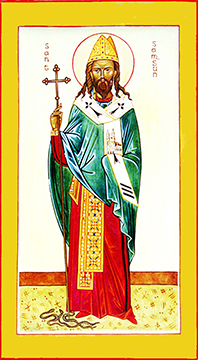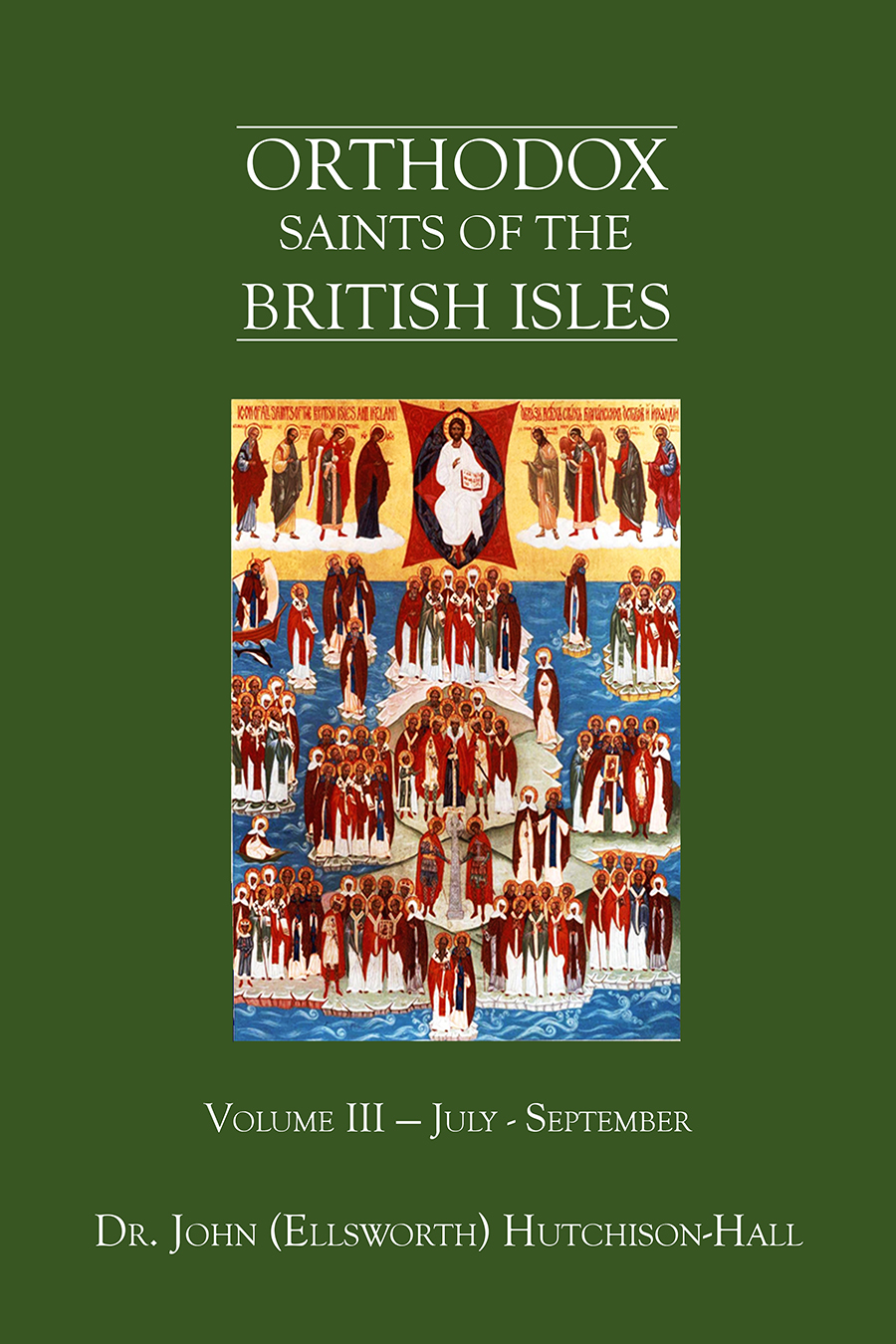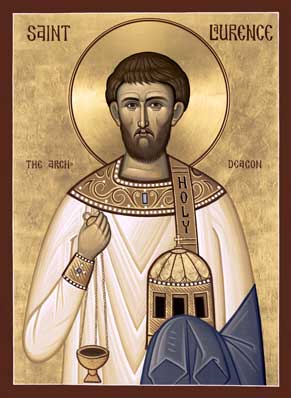
Orthodox Saints of the Pre-Schism
See of Rome
10th August (NS) — 28th July (OS) 2023
ARDUINUS (ARDWYNE) of TREPINO, there is no reliable information on this Saint extant, however there are those who say he was one of four English pilgrims who reposed whilst on a pilgrimage to Rome in the seventh century. St. Arduinus is venerated as the Patron Saint of the town of Ceprano (Lazio region of central Italy).
CAMELIAN, a disciple of St. Loupus of Troyes (29th July). St. Camelian succeded St. Loupus in the See of Troyes (north-central France) in 478. St. Camelian is listed amongst the attendees of the First Council of Orléans which was held in 511. He reposed circa 525
INNOCENT I, Pope of Rome from 402 until his repose 417. During his Pontificate he brought many back to the Church who had fallen away from orthodoxy through the Novatian Schism, defended St. John Chrysostom during the later's banishment to the Caucasus in Georgia, was one of the leaders in the condemning of Pelagianism, and had to contend with the 410 sack of Rome by Alaric I, King of the Visigoths (r. 395–410).
LUCIDUS (LUCIDO) of AQUARA, a monk at St. Peter's Abbey near Aquara (south-western Italy). St. Lucidus reposed circa 938, and nothing further about his life is known.
LYUTIUS, a monk at Monte Cassino, who spent his last years as a hermit at La Trinità della Cava near Cava de'Tirreni, in southern Italy. St. Lyutius reposed circa 1038.
Troparion of Martyrs Nazarius, Protase, Gervase, and Celsus of Milan — Tone IV
Let us praise the fourfold company of martyrs:
Nazarius, Protase, Gervase, and Celsus.
For they preached the Trinity to all
And by their contest dispelled the worship of idols.
Through their prayers, O Christ God, have mercy on us all.
NAZARIUS and CELSUS of MILAN, (on Eastern Calendars 14th October with SS. Gervase and Protase), two martyrs in Milan who were beheaded circa 68 on the orders of Emperor Nero (r. 54–68). According to a legend of dubious veracity, St. Nazarius was a son of Perpetua, a disciple of the Apostle Peter (29th June), who also catechised St. Nazarius.
PEREGRINUS, (Second Century), very little information on this saint remains, he seems to have been a priest of the Diocese of Lyons (east-central France) during the episcopacy of St. Irenaeus of Lyons (28th June), who in the latter half of the second century lived as a hermit on an island in the River Saône.
SAMSON (SAMPSON) of DOL, one of the greatest missionaries of the sixth century in western Europe, St. Samson of Dol evangelised for Christ in Ireland, Cornwall (England), the Channel Islands, and Brittany (north-western France). A Welsh monk, St. Samson began as a disciple of St. Illtud (6th November) at his great nursery of saints, Llantwit Major, in the south of Glamorgan, Wales, and then went onto Caldey Island, where he served as abbot. Having been instructed in a vision, St. Samson left Caldey, living for a while as a hermit near the River Severn. He then went to Ireland, and then Cornwall where his was consecrated bishop by St. Dubricius of Wales (14th November). St. Samson finally settled in Brittany, where he spent the rest of his life enlightening the Bretons from his base at Dol. The exact date of St. Samson’s repose in unknown, however, records show that he attended the Councils of Paris in 553 and 557, so he reposed sometime after 557. He was almost immediately venerated as a saint. Initially buried at Dol, St. Samson’s relics were later translated to Paris.
VICTOR I, a native of Tunisia in North Africa who was the fourteenth Pope of Rome from circa 189 until his repose circa 198. Whilst he introduced Latin as the liturgical language in the Roman See, displacing Greek, which had been used since the See was founded, St. Victor is best known for his role in the Quartodeciman Controversy, during which he initially attempted to excommunicate eastern parishes who were observing Easter following an older and different calculation of the date the feast was to be observed. Most sources list him as the first native of Africa to have been Bishop of Rome, and as a martyr.
Get your copy of Orthodox Saints of the British Isles today.
Available at Amazon or your favourite e-bookstore.
AGUILBERTE of JOUARRE, the second Abbess of the Abbey of Our Lady of Jouarre (abbaye Notre-Dame de Jouarre) in Jouarre (north-central France). St. Aguilberte reposed circa 680.
AREDIUS (ARIDIUS, AREGIUS) of LYONS, Archbishop of Lyons (east-central France) from 603 until his repose in 615. St. Aredius was a highly regarded theologian who actively fought against heterodoxy.
ASTERIA (HESTERIA) of BERGAMO, martyred circa 307, St. Asteria has been venerated since the fourth century, in Bergamo in Lombardy (northern Italy). According to ancient tradition she was beheaded during the Diocletianic Persecution (303–313). She is also associated with St. Grata of Bergamo (1st May) in the burial of the holy martyr St. Alexander of Bergamo (26th August).
BASSA, PAULA, and AGATHONICA of CARTHAGE, (Date Unknown), nothing is known of these three maidens, other than the have been listed in the major martyrologies for generations as martyrs at Carthage (a present-day suburb of Tunis, Tunisia) in north Africa.
BETTELIN (BERTRAM) of ILAM (STAFFORD), (Eighth Century), in the Anglican Church of the Holy Cross at Ilam, Staffordshire, is the Chapel of St. Bertram, built in 1618 by the Meverell, Port, and Hurt families. The chapel holds the remains and shrine of St. Bertram, an Anglo-Saxon saint, whose existence is most likely entirely legendary. All the information on St. Bertram, or Bettelin, seems to come from a Life in the 1516 edition of the Nova Legenda Angliæ. St. Bertram is described as a seventh or eighth century Mercian King who renounced his title and wealth, and abandoned the world. He became a hermit in the area that is present-day Stafford, of which he is patron saint. This Life is confused and intertwined with that of St. Bettelin (9th September), and it is possible, if not probable, that they are one and the same person.
Troparion of St. Bettelin (Bertram) of Stafford — Tone VIII
Like new-born lambs are we lacking in any defence, unable to
withstand the onslaughts of the spiritual wolves who seek ever
devour us; but do thou, O righteous Bertram, come unto our aid,
and with the staff of God's grace which abideth in thee drive far
from us the savage minions of Satan, that by thine entreaties we
may find safety and rest in the fold of Christ in paradise.
BLANE (BLAAN, BLAIN), (Sixth Century), according to the Aberdeen Breviary St. Blane was a disciple of SS. Comgall of Bangor (10th May) and Canice (Kenneth) of Aghaboe (11th October). He was consecrated Bishop of Kingarth in the Isle of Bute in Scotland at the end of the sixth or beginning of the seventh century. Following his repose, St. Blane was buried at Dunblane, where the Cathedral and several churches are dedicated to his honour. However, there is debate regarding the dates generally given for his life. If, as it is thought, he was a disciple of SS. Comgall and Kenneth then his birth must have been after 550. However, English Roman Catholic priest and renowned hagiographer Fr. Alban Butler (†1773), and Scottish scholar, antiquarian, and historian, Thomas Dempster (†1625) insist that St. Blane flourished in the tenth or eleventh century, perhaps confusing St. Canice (Kenneth) with Kenneth, King in Scotland (†c. 1000). The pre-eminent hagiographic scholars of the Société des Bollandistes (the Bollandists) reject the theory that St. Blane studied under of SS. Comgall and Canice. This leads to the contemporary hypothesis that there were two different St. Blanes, one who lived in the sixth century, and a second who lived in the eleventh century.
DEUSDEDIT the COBBLER, (Sixth Century), a poor shoemaker in Rome. According to St. Gregory the Dialogist (3rd September), who was a contemporary, each Saturday, St. Deusdedit gave away to the poor all that he had earned during the week beyond the minimum necessary for basic sustenance.
Troparion of St. Gerontius (Geraint) — Tone VIII
Thou wast a Confessor for the Faith, a friend and father of saints
and a wise and pious king, O holy Geraint.
Even in the Age of Saints thy virtues shone forth, O righteous one,
and as thou wast a shining beacon guiding thy subjects in Devon into the way of salvation,
intercede we beseech thee, with Christ our God,
for those who call upon thee, that He will save their souls.
GERONTIUS (GERAINT), (Sixth Century), St. Gerontius was a King of Dumnonia (present-day Devon England) who fell circa 508 in battle against the pagan Saxons. Numerous romantic legends have evolved over time about his life and that of his wife, Enid, all of doubtful veracity. The first known mention of him is in the 12th century Exeter Martyrology, which refers to a King Gerontius, though not as a saint. An Exeter Litany attributed to Bishop Leofric of Exeter (†c. 1072) mentions a St. Gerontius. Another Gerontius, a King of Cornwall who reposed in 596, is listed as a saint in some works, though without a feast date, and may be the same person. A modern scholar with the Société des Bollandistes (the Bollandists) has speculated that the first Gerontius was a local saint who was elevated to the status of king in the writings of later hagiographers.
LAURENCE of ROME, the holy, glorious, and right-victorious Archdeacon and Martyr St. Laurence was an archdeacon of the Church of Rome as well as a companion of Pope St. Sixtus II (6th August), both of whom were martyred in 258 in the persecutions during the reign of the Emperor Valerian (r. 253–260). Little is known about St. Laurence’s life. According to legend he was a native of Northern Spain, and possible accompanied Pope St. Sixtus to Rome when he was elevated to Bishop of that See. The Basilica of San Lorenzo in the Via Panisperna, Rome was built over the place of his martyrdom.
Troparion of Martyr and Archdeacon St. Laurence of Rome
Tone IV
Victorious martyr of Christ our God,
by the sign of the Cross you gave sight to the blind;
you distributed the riches of the Church to the poor;
you were tried by fire and no evil was found in you.
As you endured the burning,
may your prayers extinguish the flames of our many sins,
blessed Archdeacon Lawrence!
Kontakion of Martyr and Archdeacon St. Laurence of Rome
Tone II
Your heart burned with divine fire
as the flames of the passions died within you
God-bearing martyr Lawrence, the pillar of those who struggle,
you cried out in the midst of your contest:
"Nothing can separate me from the love of Christ."
MARTYRS of ROME, one hundred and sixty-five Christian soldiers martyred in 274 at Rome in the persecutions during the reign of the Emperor Aurelian (r. 270–275).
THIENTO (THIENTE) of WESSOBRUNN and COMPANIONS, an Abbot of the Abbey of SS Peter and Paul (Kloster Wessobrunn) near Weilheim in Bavaria (Germany). St. Thiento in 955 was martyred, along with six of his monks, by invading Magyars.
Prior to the Schism the Patriarchate of Rome was Orthodox, and fully in communion with the Orthodox Church. As Saint John of Shanghai and San Francisco +1966 said “The West was Orthodox for a thousand years, and her venerable Liturgy is far older than any of her heresies”.
Details of British Saints excerpted from Orthodox Saints of the British Isles.
Details of continental saints from these sources.
In many cases there are several spelling versions of the names of saints from the British Isles. I use the Oxford Dictionary of National Biography version as the primary version with the more prevalent version in parenthesis e.g. Ceadda (Chad) of Lichfield.



